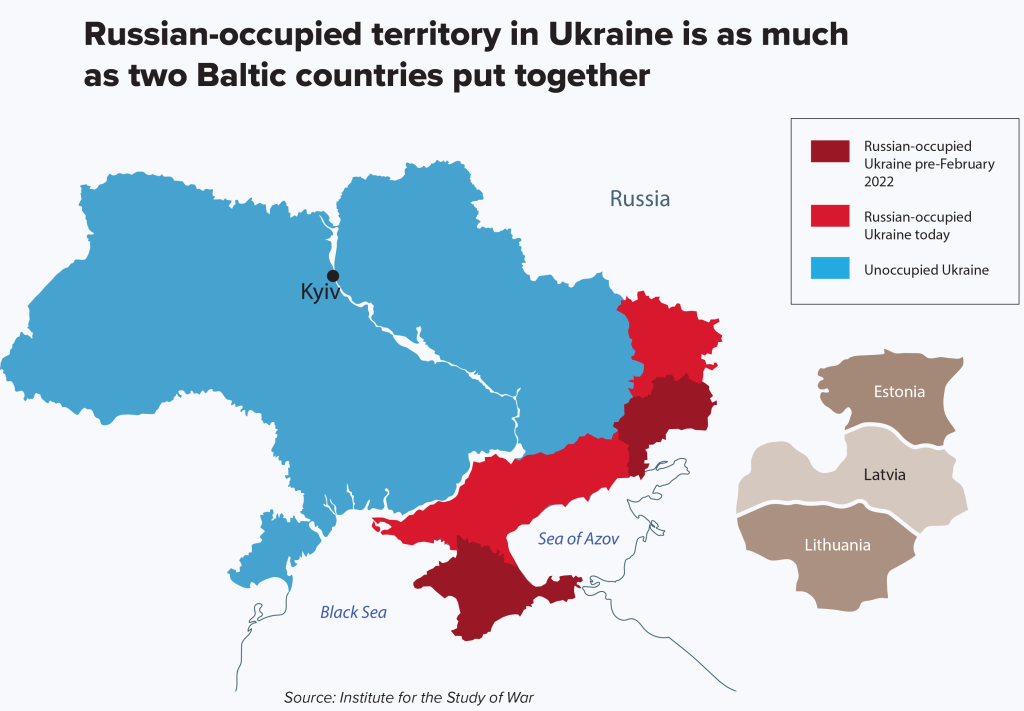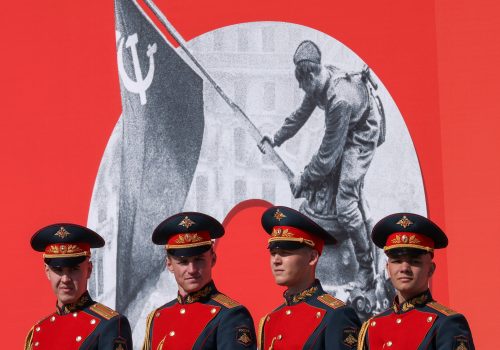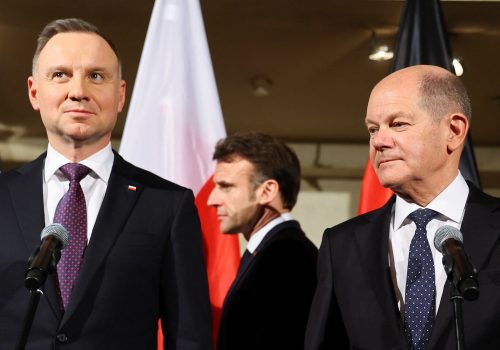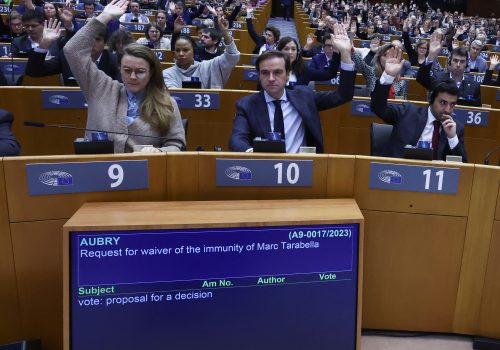One year, eight world-changing numbers. Quantifying Russia’s war in Ukraine.
One year ago, Russian troops streamed over the borders of Ukraine in the dead of night in an attempt to swiftly seize the country and topple its government. Instead they met with remarkable Ukrainian resistance and the rallying of Ukraine’s international allies to its defense, thwarting Russian President Vladimir Putin’s plans. It is hard to calculate the suffering, destruction, and global upheaval caused by the conflict, which has evolved into a brutal war of attrition with no end in sight. But there are some eye-opening numbers that help tell this story. To mark one year since Putin’s full-scale invasion, experts from across the Atlantic Council have identified the figures they believe best illustrate all the ways this war has shaken the world.
108,000
Approximate amount of Ukrainian territory occupied by Russia, in square kilometers
Many analysts see Russia’s failure to topple Kyiv as a sign of Russian weakness. They argue that Washington and Brussels need not worry about Russia’s threat to NATO because Russia’s military is weaker than we thought. These data tell a different story: Russia’s invasion of Ukraine shows that Moscow—which controls roughly 108,000 square kilometers of Ukrainian land, according to Institute for the Study of War data analyzed by the New York Times—is capable of seizing and occupying territory on its border the size of two Baltic states. Estonia’s total territory is about 45,000 square kilometers, while Latvia checks in at 64,000 and Lithuania at 65,000. The Russian military is potentially strong enough to cause World War III and break NATO. These are the data that keeps US European Command planners and vulnerable Eastern flank NATO allies up at night.
—Matthew Kroenig is the senior director of the Scowcroft Center for Strategy and Security.

8 million+
Refugees from Ukraine recorded in Europe since the start of the war
Russian atrocities in Ukraine over the past year have caused untold disaster and spurred the largest humanitarian crisis in Europe in nearly eighty years. The Kremlin has launched unrelenting assaults on civilian infrastructure, culminating in the deaths of civilians and permanently damaging energy facilities. Meanwhile, over fifty thousand allegations of war crimes have emerged from recently liberated Ukrainian cities, including harrowing reports of mass graves, torture in detainment camps, and the utilization of sexual assault as a weapon of war.
As a result, Europe has opened its doors to more than eight million refugees fleeing from Ukraine for their safety. While the prevailing belief is that large, Western European countries have led Europe’s efforts to counter Russia’s aggression, Central and Eastern European countries bear the brunt of refugee waves coming from Ukraine—due to both their proximity and already established Ukrainian diaspora communities. Nearly one-third, or 2.5 million, of total refugees from Ukraine in Europe have settled in countries included in the United Nations’ Refugee Response Plan (Bulgaria, the Czech Republic, Hungary, Poland, Moldova, Romania, and Slovakia), while Poland has settled the greatest number of refugees at over 1.5 million and has seen over eight million refugees cross its border seeking safety since the start of the war (though six million have also returned to Ukraine).
Looking at the refugees taken in as a proportion of national population, Estonia, Montenegro, and the Czech Republic top the list, while some larger countries such as France and the United Kingdom fall toward the bottom. As Ukraine’s closest neighbors, Central and Eastern European countries have served on the front line of Europe’s greatest refugee crisis in generations and are likely to continue doing so as the war enters its second year.
—Kristen Taylor was a Young Global Professional at the Europe Center in the fall of 2022 and is a master’s student at American University. Akshat Dhankher and Emma Nix are program assistants at the Europe Center and lead the Ukraine Aid Tracker project.
Nearly 90%
Reduction in Russia’s piped natural gas export volumes
Russia’s piped natural gas export volumes have shrunk from four hundred to five hundred million cubic meters (mcm) per day to around sixty mcm per day, one year after Putin unleashed his bloody war of choice on Ukraine and an energy assault on Europe, Moscow’s biggest energy consumer at the time. Neither is going as planned.
While oil and gas are vital for Russia’s state budget, Moscow leans heavier on oil exports for revenue and gas exports for geopolitical leverage, which Putin unleashed by abruptly stopping supplies to multiple nations in Europe in order to discourage support for Ukraine. But by cutting supplies, Moscow also cut itself out of the European market as nations adjusted to the massive curtailment—albeit at a hefty price. Much of the market share will be challenging or impossible to recover, regardless of the war’s outcome, as European buyers commit to long-term contracts with alternative suppliers and invest in new liquefied natural gas (LNG) infrastructure to bring gas to areas previously monopolized by Russian exports.
However, a full decoupling from reliance on Russian gas is far from complete. New projects must come online to fill the supply gap in the long term, and the allure of discounted Russian exports could tempt some regions in Europe to take in gas from the Kremlin after the war. Additionally, Russian LNG exports to Europe increased in 2022—an important trend for European nations to observe as they work to unburden themselves from dependance on an unreliable producer.
Nevertheless, Putin accelerated Europe’s preexisting diversification efforts with his energy blackmail and, ironically, without Western sanctions on Russian methane. Moscow will never again supply 40 percent of Europe’s natural gas.
—Olga Khakova is the deputy director for European energy security at the Global Energy Center.
60.2%
Amount of Russia’s forecasted 2023 budget deficit reached by January
Moscow’s budget deficit in the month of January alone is more than half of its planned deficit for the entirety of 2023. Looking at the below graph, you’ll see a clear surge in Russia’s budget deficit in December. While December spending in Russia is usually high, January remained far into negative territory at a loss of 1.8 trillion rubles. Why the mismatch with Moscow’s predictions?
It’s because the 2023 budget is calculated based on oil revenues coming in at sixty dollars per barrel—the same value that the Group of Seven (G7) nations set as its price cap on December 5—but prices have since dropped well below that mark. With income shrinking, and heavy costs of the war to bear, Russia’s budget deficit is likely to widen past its own 2023 estimate of 2.9 trillion rubles.
—Sophia Busch is a program assistant at the GeoEconomics Center.
52.5%
Proportion of Russia’s tank arsenal destroyed
Prior to last February’s full-scale invasion of Ukraine, Russia was estimated to possess around 3,330 operational tanks. After one year of fighting, open-source intelligence has visually confirmed that Russia has lost over 1,700 tanks, or just over 50 percent of its pre-war total operational stocks. One estimate suggests that the total lost could be over 70 percent, given that not all losses are accessible to open-source intelligence. Russia is estimated to have around 17,000 additional tanks in storage, ranging from early Cold War-era T-55s, T-62s, and T-64s to more recent T-72s, T-80s, and T-90s, however the condition of these stored tanks is unclear.
—Jeffrey Cimmino is an associate director in the Scowcroft Strategy Initiative in the Scowcroft Center for Strategy and Security.
21
Countries with domestic accountability responses to Russia’s invasion
The response to Russia’s full-scale invasion of Ukraine—and the 68,321 crimes of aggression and war crimes registered by Ukraine—has included rapid international action to ensure accountability. Ukraine tops the list with domestic investigations and trials, advocacy to establish a Special Tribunal on the Crime of Aggression, and work to establish a claims commission. However, other countries have followed suit with domestic processes including criminal investigations, targeted sanctions designations, and asset seizures, as well as coordinated efforts through a joint investigative team and the Russian Elites, Proxies, and Oligarchs Task Force.
This is an atypical amount of legal action. This is partly due to practical reasons: Ukraine has an incentive to cooperate with other jurisdictions, and countries close to Ukraine are likely to have refugees who can provide evidence and perpetrators arriving on their territory. However, there are also known double standards in global access to justice—there is less clamor for international action when the perpetrators are from politically well-connected Western countries or part of intractable conflicts—which are considered likely to be a contributing factor to a reported lack of support for certain measures from the Global South. These accountability efforts will shape international legal precedent as they progress, but authorities should also ensure that they become the norm and serve to expand the options available to all atrocity victims.
—Celeste Kmiotek is a staff lawyer for the Atlantic Council’s Strategic Litigation Project.
35
Number of countries in a new nonaligned movement
On March 2, 2022, in an emergency special session following Russia’s illegal invasion of Ukraine, the United Nations General Assembly advanced resolution ES-11/1 demanding full withdrawal of Russian forces from Ukraine. A total of 141 countries voted in favor of the resolution, including many of the world’s democracies. Thirty-five countries, from China and India to Iran and South Africa, abstained. Five countries— Belarus, North Korea, Nicaragua, Russia, and Syria—voted against it.
Seven months later, the General Assembly voted again to condemn Russia’s invasion and not recognize Russia’s claims to Ukrainian territory. The votes remained largely unchanged, with only two additional countries voting in favor (a total of 143) of a weakened resolution, thirty-five abstentions, and the same five no’s. (Several countries missed the vote in both cases.)
Both votes show that the international community overwhelmingly stands together to rebuke Russia’s invasion. But such little movement in vote numbers and member groupings—after nearly a year of an increasingly brutal and illegal war, human-rights abuses and apparent war crimes, and massive disruptions to the global economy—suggests that the world is roughly divided into three blocs. The first is a collection of countries, encompassing many members of the free world, that stand together to defend international law and order when it is most under threat. The second is a new nonaligned movement of countries that, for varied political or strategic reasons, choose to hedge or stay out of the fray completely. The third is an “axis of autocracies” that act to disrupt or displace the rules-based order.
These groups are of course not exact or exhaustive. Many states who voted in favor of both resolutions are not free or democratic or may not be supportive of more punitive steps to punish Russia, such as sanctions. Still, how countries have voted on these resolutions displays a real fact of today’s global order: Countries are increasingly coalescing into democratic and autocratic blocs when responding to international issues, with some remaining non-aligned.
—Danielle Miller and Imran Bayoumi are assistant directors with the Scowcroft Strategy Initiative.
50 billion euros
Monetary value of assistance sent to Ukraine by the EU and its member states since the start of the war
Despite the Kremlin’s bet that its war of aggression would isolate Ukraine from Europe, the European Union (EU) and its member states have responded with unity of purpose by sending immediate and continued aid to Ukraine.
An estimated 12 billion euros of this assistance was dispatched in the form of military aid, which accounts for both the 3.6 billion euros the EU has contributed via the European Peace Facility and bilateral donations from twenty-four EU member states. European partners not only sent a major wave of this military assistance immediately after Russia’s initial incursion but have also sustained donations throughout the year since—progressively sending heavier and longer-range weaponry—suggesting growing trust in Ukraine’s defensive capabilities and an increasing realization that Ukraine is the front line for the defense of Europe overall.
Meanwhile, an estimated 1.7 billion euros has taken the form of humanitarian aid, which has provided food, clothing, shelter, health care, and other basic needs to nearly fourteen million people in Ukraine. The European Commission has coordinated this unprecedented operation under the auspices of the EU Civil Protection Mechanism, standing up logistical hubs in Poland, Romania, and Slovakia to direct aid into the country. Lastly, as the challenge of Ukraine’s physical and institutional reconstruction looms ahead, the EU has provided 7.2 billion euros in macro-financial assistance—with an additional 18 billion euros of loans approved by the European Council in December 2022—and is sending other financial support through the European Investment Bank and the European Bank for Reconstruction and Development.
—Akshat Dhankher and Emma Nix are program assistants at the Europe Center and lead the Ukraine Aid Tracker project.
Further reading
Wed, Feb 22, 2023
Russia policy after the war: A new strategy of containment
New Atlanticist By Alexander Vershbow
To prevent further damage to the rules-based international order, the United States and its allies will need a strategy of containment to deter Russia militarily and decouple Russia from the international community, until Moscow has earned the right to be considered a partner once more.
Wed, Feb 22, 2023
What I heard in Munich: Four fears are holding the West back from quicker, bolder support for Ukraine
New Atlanticist By Anna Wieslander
There is fear of escalation, fear of having Ukraine fully in the European family, fear of a defeated Russia, and fear of a defeated Ukraine.
Thu, Feb 2, 2023
In 2022, the war in Ukraine awakened Europe. Here’s how it must adapt in 2023.
New Atlanticist By
How will the EU continue to bolster its security? Can Brussels forge a new path toward better relations with its partners? Our experts give their recommendations on how to get there.
Image: Ukrainian personnel hold a Ukrainian flag as they pose on top of a Challenger 2 tank during training at Bovington Camp, near Wool in southwestern Britain, February 22, 2023. REUTERS/Toby Melville



